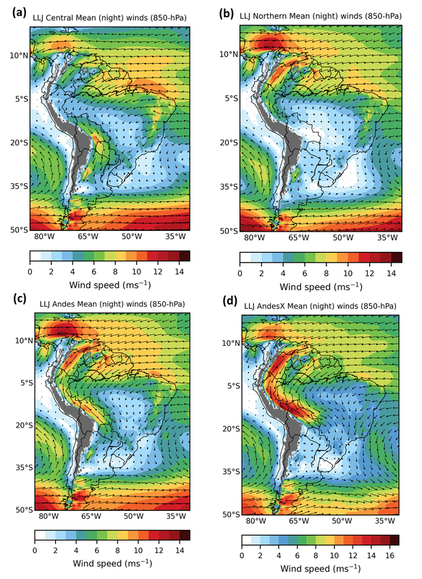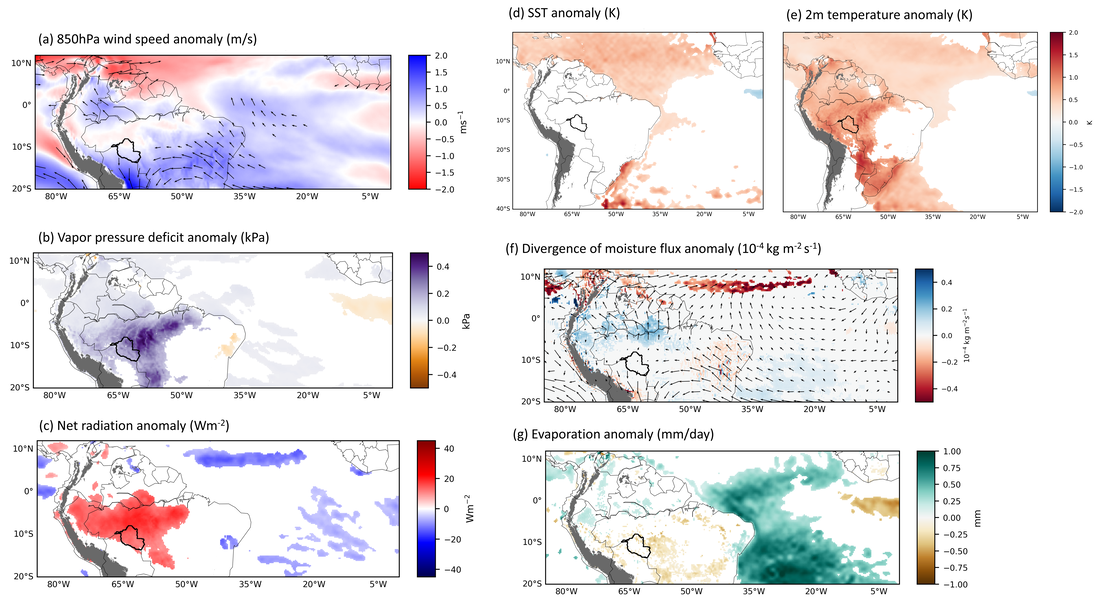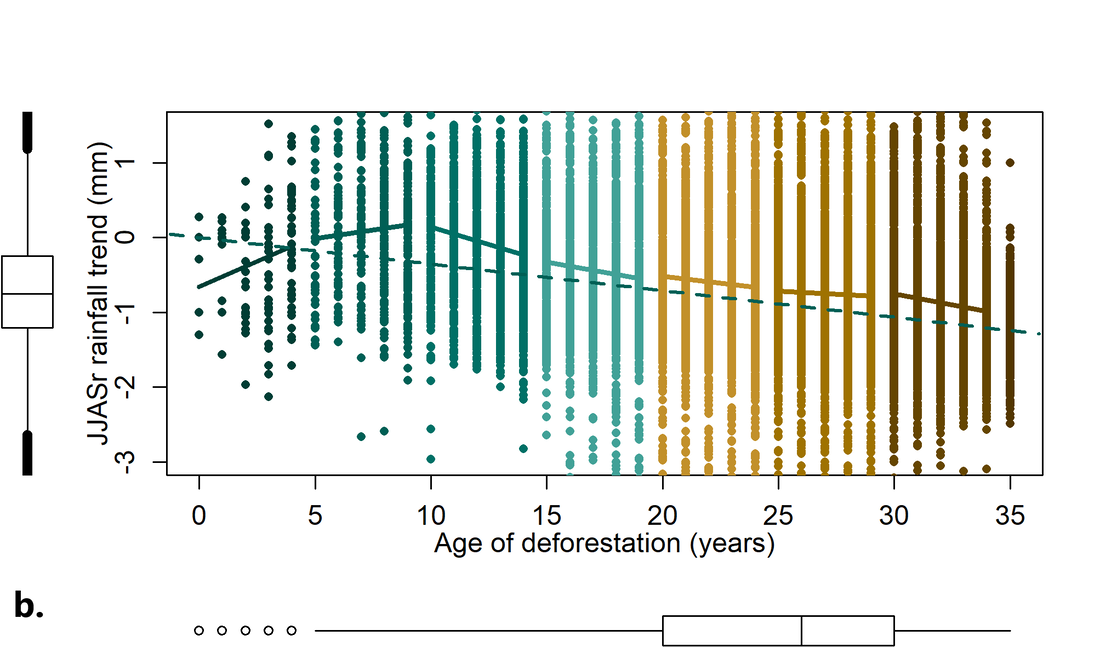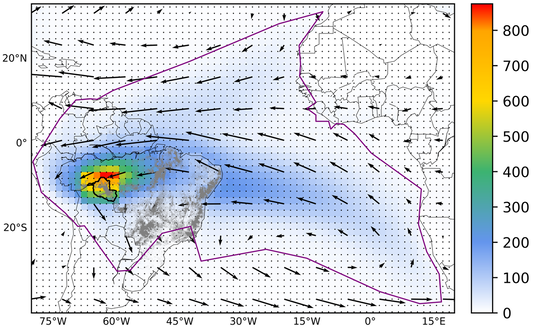Recent Highlights
|
Composites of winds at 850-hPa during (a) Central LLJ, (b) Northern LLJ, (c) Andes LLJ, and (d) Andes-X LLJ types
|
The South America Low-level Jet: form, variability and large-scale forcings
Northerly low-level jets (LLJ) along the eastern Andes are important conduits of moisture transport and play central roles in modulating precipitation in South America. This study further investigates the variability of the LLJ during extended austral summers. A new method characterizes the spatial extent of the LLJ and finds four distinct types: Central, Northern, Andes and Peru. We show the existence of specific evolutions such that the LLJ may initiate in the central region, expands along the Andes and terminates in the northern region. Conversely, the LLJ may propagate from north-to-south. The spatiotemporal evolution of the LLJ is remotely forced by Rossby wave trains propagating from the Pacific Ocean towards South America, and the different phases of the wave trains favor the occurrences of Central, Northern or Andes types. Occurrences of Central and Northern types are more frequent in El Niño and La Niña years, respectively. The persistence of precipitation is shown to be directly related to the persistence of the LLJ. Lastly, the Madden-Julian Oscillation plays an important role in generating wave trains modulating the frequency of LLJ, especially the Central type.
|
|
Circulation Changes are Important for Dry Season Moisture Sources and Recycling in the Brazilian Amazon
Water is redistributed from evaporation sources to precipitation sinks through atmospheric moisture transport. This study investigates moisture sources for dry season rainfall in the state of Rondônia in Brazil, especially during drought years. Using a precipitationshed framework, we quantified the variability of moisture contributions to rainfall in the state of Rondônia (Brazilian Amazon) and the influence of synoptic circulation patterns. Ocean evaporation accounts for 58% of mean dry season precipitation while continental recycling contributed 42%. During drought years, although forests maintain or increase evapotranspiration, the moisture contribution of both ocean and forests to dry season rainfall decreases due to the synoptic circulation changes, reducing the moisture transport into Rondônia.
|
Mean drought years anomalies of (a) 850 hPa wind; (b) Vapor pressure deficit; (c) Net radiation; (d) Sea surface temperature; (e) 2m air temperature; (f) vertical integral of divergence of moisture flux and 850 hPa wind vectors; Positive moisture flux divergence anomalies indicate diverging of moisture and negative anomalies indicate converging of moisture and (g) Evaporation. The outlined region indicated the sink region Rondônia. Gray shading represents the Andes Mountains. Only statistically significant values in the T-test at 90% confidence intervals at 0.1 level (p < 0.1) are shown.
|
|
Older Deforested Regions in the Brazilian Amazon Have Reduced Rainfall During the Dry Season
This study analyzes spatiotemporal trends in rainfall between 1981 and 2020 and relationships with deforestation age in the Brazilian Legal Amazon (BLA). An improved rainfall dataset is derived by calibrating the Climate Hazards Group Infrared Precipitation with Stations (CHIRPS) data with observations from a rain gauge network in the BLA. While large spatial variability is observed, the results show coherent relationships between negative dry-season rainfall trends and old-age deforested areas. Deforestation aged up to a decade enhanced rainfall and older deforested regions have reduced rainfall during the dry season. These results suggest substantial changes in the hydroclimate of the BLA and increased vulnerability to future land cover change.
|
Scatterplot of the age of deforestation and dry season rainfall trend in the BLA. The solid lines indicate the regression slope for each group at the 5 years interval. The dashed line indicates the overall trend line.
|
|
Moisture sources for annual precipitation in Rondônia from 1981 to 2018 (mm/year); the region in the map accounts for 94.4% of the moisture sources. The magenta line indicates the 1-mm precipitationshed boundary. Arrows indicate the average horizontal (vertically integrated) moisture flux. Grey areas indicate non-forested areas.
|
Forests Mitigate Drought in an Agricultural Region of the Brazilian Amazon
Using a precipitationshed moisture tracking framework, we quantify the contribution sources of evaporation to rainfall in Rondônia in the Brazilian Amazon. Forests account for approximately 48% of annual rainfall on average, and more than half of the forest source is from protected areas (PAs). During droughts in 2005 and 2010, moisture supply decreased from oceans and non-forested areas, while supply from forests was stable and compensated for the decrease. Remote sensing and land surface models corroborate the relative insensitivity of forests to droughts. Forests mitigate drought in the agricultural study region, providing an important ecosystem service that could be disrupted with further deforestation.
|
|
Sundowner winds in Santa Barbara, California. Credit: Jones et al. (2021)
For more information of SWEX: www.eol.ucar.edu/field_projects/swex |
Fieldwork: Sundowner Winds Experiment (SWEX)
Wildfires affecting coastal Santa Barbara have been enhanced by strong winds in the southern slopes of the Santa Ynez Mountains: “Sundowner Winds” (or Sundowners). The main scientific objectives of the “Sundowner Winds Experiment” (SWEX) are: Investigate how boundary layer structure and dynamics spanning the SYM and Santa Ynez Valley influence Sundowner winds intensity, timing and geographic characteristics; Examine mechanisms relating high amplitude mountain waves, critical layers, and surface wind intensity; Investigate how variations in boundary layer structure and tropospheric stability impact the predictability of Sundowner winds. Ye is participating in the SWEX radiosonde fieldwork.
|





